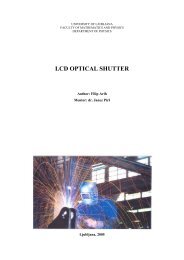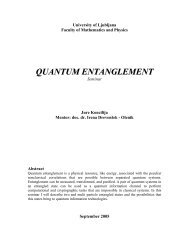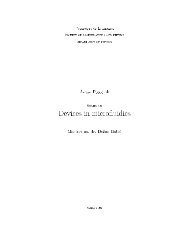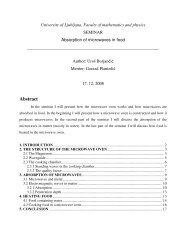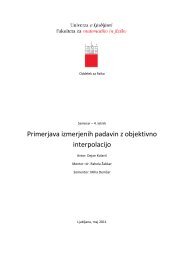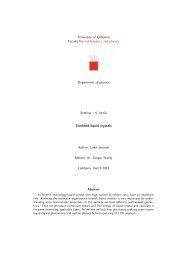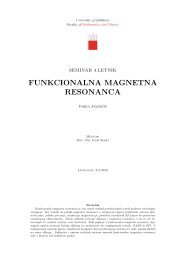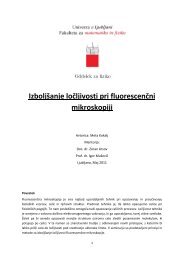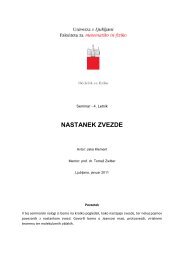Create successful ePaper yourself
Turn your PDF publications into a flip-book with our unique Google optimized e-Paper software.
disorder (which tends to localize the wavefunctions) and by the Coulomb interaction, which binds<br />
electrons when transferred to a nearby repeat unit to the positive charge left behind (a hole).<br />
The construction of the remarkably successful SSH Hamiltonian is based on two assumptions [2]:<br />
(a) The π-electronic structure can be treated in the tight-bonding approximation with a transfer integral<br />
t ≈ 2.5 eV, and (b) The chain of carbon atoms is coupled to the local electron density through the<br />
length of the chemical bonds.<br />
tn, n+<br />
1 = to<br />
+ α ( un<br />
+ 1 − un<br />
)<br />
(1)<br />
where tn , n+<br />
1 is the bond-length dependent hopping integral from site n to n +1 and n is the<br />
displacement from equilibrium of the carbon atom. The first assumption defines the lowest order<br />
hopping integral, , in the tight-binding term that forms the basis of the Hamiltonian (Eqn. 2). The<br />
second assumption provides the first-order correction to the hopping integral. This term couples the<br />
electronic states to the molecular geometry, giving the electron-phonon (el-ph) interaction where α is<br />
the el-ph coupling constant. The precise form of Eqn. (1), in which the dependence of the hopping<br />
integral on the C-C distance is linearized for small deviations about , is the first term in a Taylor<br />
expansion.The resulting SSH Hamiltonian is then written as the sum of three terms:<br />
u<br />
th<br />
n<br />
to<br />
to<br />
H<br />
∑<br />
2<br />
+<br />
+<br />
pn<br />
1<br />
2<br />
[ −to<br />
+ α ( un+<br />
1 − un<br />
)]( cn+<br />
1,<br />
σ cn,<br />
σ + cn,<br />
σ cn+<br />
1.<br />
σ ) + ∑ + K∑(<br />
un<br />
1 − un<br />
) (2)<br />
2m<br />
2<br />
SSH = +<br />
n,<br />
σ<br />
n n<br />
where pn are the nuclear momenta, n are the displacements from equilibrium, m is the carbon mass,<br />
and K is an effective spring constant. The and are the fermion creation and annihilation<br />
operators for site n and spin σ. The last two term are, respectively, a harmonic »spring constant« term<br />
which represents the increase in potential energy that results from displacement from the uniform<br />
bonds lenghts in (CH)x and a kinetic energy term for the nuclear motion.<br />
u<br />
+<br />
cn, σ cn,<br />
σ<br />
Figure 6: Electronic structure of semiconducting PA; left - Band structure, right - Density of<br />
states. The energy opens at k = π/2a as a result of Peierls distortion<br />
The spontaneous symmetry breaking due to the Peierls instability implies that for the ground state<br />
of a pristine chain, the total energy is minimized for u n > 0 .Thus to describe the bond alternation in<br />
the ground state, we use:<br />
u )<br />
n<br />
n → un<br />
= (−1<br />
uo<br />
(3)<br />
With this mean-field approximation, the value uo<br />
which minimizes the energy of the system can be<br />
calculated as a function of the other parameters in the Hamiltonian. Qualitatively, however, one sees<br />
6



